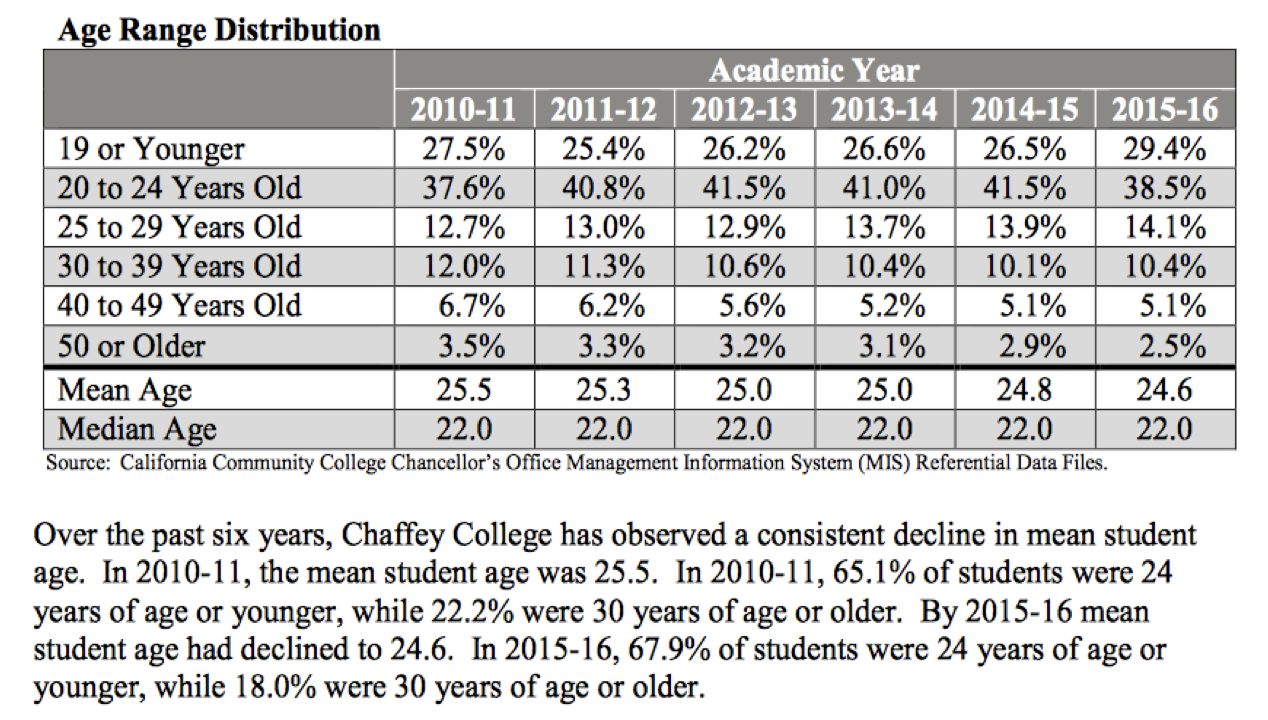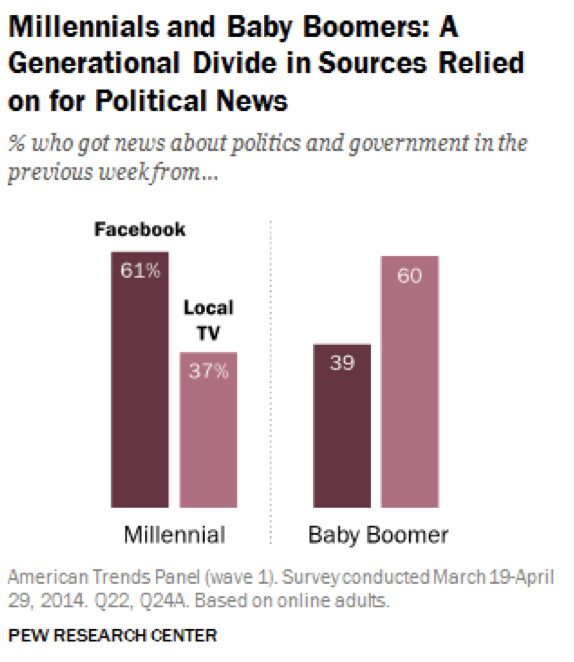The Future Of Journalism
Technology has pioneered a new wave of American journalism. Considering roughly 70% of households obtain access to a broadband network, an estimated 70% of young adults 18-29 admit receiving their news from social media, according to Pew Research Center.
Chaffey College is a community consisting primarily of individuals between the ages 19-29. This demographic proves a high velocity in social media usage, resulting in a digital dependency redefining the way journalism is perceived.
A graph of student age demographics at Chaffey College. Photo courtesy: Chaffey College.
On Tuesday, December 12, 2017 Chaffey College students from the Fontana and Rancho campus were randomly asked about their social media usage and news gathering methods to get a better idea of what the future holds in journalism.
Mathematics major Andres Mora, 23, was the first to state radio was his primary news source:
“Nowadays, most news outlets are very biased and that’s the thing, being in the news, you have to try to be non-biased because everyone wants the full story. Not just one side or the other,” he said. He used a comparison between American and Spanish news, specifically crime news reporting, stating that Spanish news shows more evidence such as actual footage of the crime scene, as opposed to American news reporting after the incident happened.
Seth Northway, a colleague of Mora’s, 18, added, “Sometimes you’re bombarded with the news when you don’t want it.” He suggested presenting the news in a way that people would want to see it, referring to fewer ads.
The Society of Professional Journalists (SPJ) state in their mission: “It is the role of journalists to provide […] information in an accurate, comprehensive, timely and understandable manner.” In their Code of Ethics, SPJ list four main principals in upholding professional journalism: Seek Truth and Report It, Minimize Harm, Act Independently, and Be Accountable and Transparent. While many people do not specifically pay attention to transparency and independent components, Mora and Northway’s testimonies prove that it is highly noticeable if not completely upheld.
National outbreaks and general news stories are entirely prevalent in American culture. To dig deeper into this topic, a member of the Baby Boom generation, George Olsen, 63, portrayed his interpretation of today’s current news coverage:
“[Back then] We only had channels 2, 4, 5, 7, 9, 11, and 13. The major news was on channel 7 (ABC) and sometimes CBS. But it wasn’t all day. It was only around 6 and 10 o’clock [p.m.],” Olsen said. His primary news source is television, dating back to the 60s. He mentioned that today’s news is “silly,” referring to the increase in political news coverage. “If there was news on politics [back then], it was because something was really happening, like the Nixon Watergate scandal. But it was news,” he said.
A newspaper clip of the Watergate scandal that occurred in August 1974. Photo courtesy: The Jewish Pluralist.
Olsen stated frequent news segments on television are “senseless,” such as car chases, where news stations typically “break into” a program to cover the same topic. “It’s more a form of entertainment,” he said, “And it doesn’t need to be every hour.”
Alternatively, “Millennials,” or those born near or in the 21st century, are described as “an unfocused audience, not particularly loyal to just one […] communication service,” according to studies by Nielson. While this demographic is consistently engaged in technology, utilizing numerous apps leads to a different view in traditional journalism.
Erika Ortega, 23, a graphic design major at Chaffey College, stated, “YouTube would be a more accessible way to get the younger demographic involved with the news.” She mentioned Instagram was her primary source of news.
“You see so much on the Internet everyday, sometimes it’s hard to believe things,” she said, “but when video is involved, it makes things easier to believe and understand.”
Ortega’s area of interest pertains to social and environmental issues. Because social media changes every day, she commented on how fast issues come and go stating, “We don’t put enough pressure on things.”
Studies from Pew Research Center show that 39% of adults 35 and older receive news from Facebook as opposed to 60% who rely on television.
Naomi McCool, a sociology professor at Chaffey College, offered a different perspective in acquiring new information via social media. “We are starting to create our virtual worlds, so we’re just seeing reinforcements of our own belief systems through the types of news that we follow, what we repost, and what our friend networks repost,” she stated, “I think it does shape less space for discourse, or at least meaningful discourse.”
National news coverage such as the Las Vegas attack that occurred on October 1, 2017, boosted a high rating of presence on social media. Given that digital media is the most up-to-date form of newsgathering, nearly every news source produced several versions on the subject. Because often times news stations are not allowed to make inferences without public official consent, there left many time gaps for the audience to assume or interpret allegations in a different way. The issue of unexplained time gaps possibly leads to false, bias or sometimes made up information.
Adding to that idea, McCool also stated, “When we lose the ability to discuss and critically analyze things from multiple perspectives, we lose a sense of decision making.”
Although younger generations are supplied with a wider variety of options that cater to the audience’s preferred method of newsgathering, this leaves many possibilities in the journalism field. Who are we and what do we care about?
In the coming years, my goal is to better understand the younger generation mindset, to bring change in my own demographic. With overbearing news stories produced every day, I aim to pinpoint the true values of journalism to uphold SPJ’s Code of Ethics and maintain the traditional values of real journalism.



